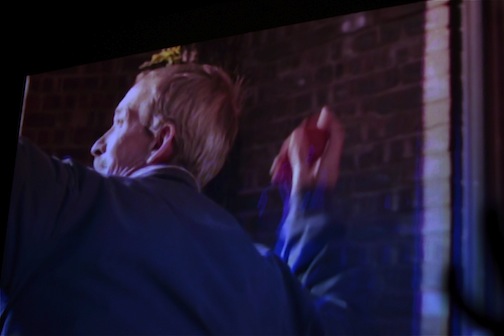
Detail from "European International LTD,Touch and Go", 2010, Cristina Lucas
Destruction is evolution in its most ferocious desperation. This year, PICA's Time Based Art Festival uses an "Evidence of Bricks" to describe the state of what it features, resolutely offering revolution as an hors d'ouevre in its title, a petite morsel with which to smash ideologies and ancient paradigms. The feast which ensues cries for change and reevaluation. "Evidence of Bricks" is an exhibition to portray the actual mindset of a zeitgeist at its tipping point, and it does, even in its failures. This year's Time Based Arts Festival fuels the fire of the revolutionary spirit. It is an exhibition everyone in Portland should see and know, and reflect on, because no, everything is not 'ok.'
The festival is so apropos to a modern condition that it is occasionally hard to watch, (thank you PICA); filled with neuroses and pain, distraction and corruption, oppression and experimentation, all self induced and created, it is a true testament to both the fragility and possibility of the times. Such is the case with the history of evolution: at such drastic and weighty turns, there is always the possibility of extinction. Yet in the midst of this tenuous state, creation is at its highest volume. This year's TBA is about the unknown and vital next step in the midst of a mirror and a corrupt conga line.
Walking into this room in the high school is somewhat of a visual breath of fresh air. In the afternoon hours during which I studied this piece, the tall windows of the room cast an even and gentle light on the tens of thousands of green matchsticks that make up this piece. Outside and below, quiet southeastern Portland streets were visible, their dim pockets promising delicious snacks and blooming moss. All held an air of calm. Claire Fontaine's magic eye map of the country seemed to alternately float above the wall and maintain the stoicism of stone. It was hypnotic and somewhat eerie. While the artistic duo that makes up Claire Fontaine maintains that their collective equals the female "ready made" artist named Claire Fontaine, the piece itself is not a ready made, yet it seems its implications are. The country is a fire hazard and a time bomb beneath the guise of well orchestrated design.
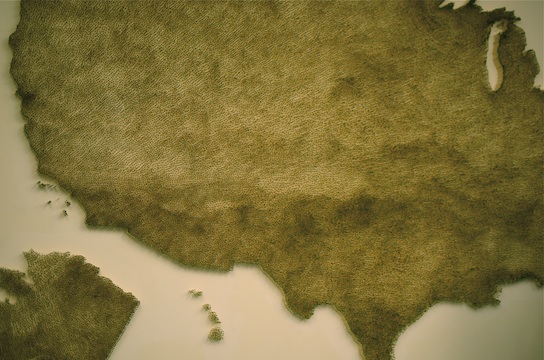
Claire Fontaine, 2011
The question surrounding this piece was whether or not it would be burnt as the others made in the same fashion had been. The discussion surrounding the work scintillated with the possible repercussive elements of "burnt/unburnt" symbolism. In the end, it was the fire marshall who decided the piece's fate, and it remained in tact and "unburnt".
As such, in tact, the Claire Fontaine piece seems much more dangerous. Despite having been doused with flame retardant and water, the matchsticks seem a pregnant menace, itching with kinetic, destructive potential. Made more dangerous by its seductive allure, it sits, a sexy fascist made of clean lines and green billowing fields: the most virulent Wonder Bread, the most poisonous pop song. Claire Fontaine wants to reiterate that all is not what it seems, that re-examination of structure is vital and that the possibility of destruction through our very material is highly possible if not eminent.
While PORT prides itself on covering visual art almost exclusively, I found it necessary to pay at least some attention to TBA:11’s rich and abundant roster of performance. TEETH's "Home Made" was a performance which could not be ignored. It portrays the violation of sanity that romantic love can be, and also its arc of tenderness, its tiptoeing towards violence. It was a storm from which I left exhausted, my empathy and my familiarity with such an experience almost too close, but one from which I could not look away.
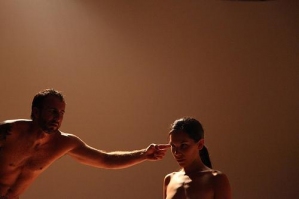
Photo by Gia Goodrich, courtesy of PICA
The performers in this piece are vulnerable weapons as they perform, the choreographer deftly relaying the equality and ferocity of brutality in such tender environs. Each bodily element is solace and weapon, savior and poison. Such is the dichotomy of romantic love. Where does it begin and end in two bodies? To Angelle Hebert and Philip Kraft, the choreographer composer duo behind "Home Made", this is suspect. The body of a professional performer is often a demure vessel, his/her training an effort to become as malleable as possible towards the whim of a choreographer's vision. Hard earned technique and precision are, of course, often the formal lures that captivate an audience, and these open the door for all the rest. Yet, in "Home Made", the body is a shaky architecture, and the walls are falling down. The piece is a couple's raw demolition in dance, naked and enraged by the chaotic torment of love gone wrong. In these moments, all is pain. The dancers in "Home Made" portray this with a sharp and gripping acrimony, defiling the sacred habits and atmospheres of sex and grace.
"Home Made" will be on White Bird's upcoming year's programming.
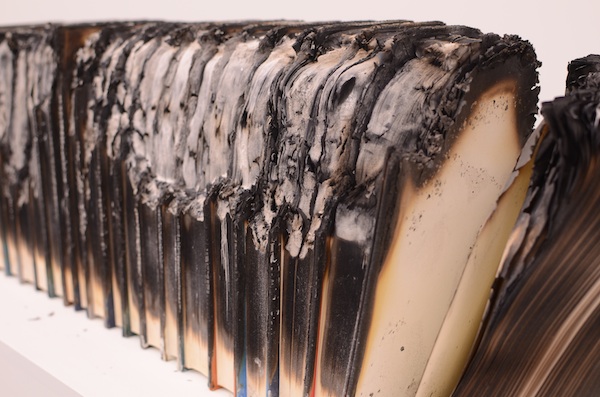 "Don't Worry, We'll Fix It, Installation Shot, Anna Grey and Ryan Wilson Paulsen
"Don't Worry, We'll Fix It, Installation Shot, Anna Grey and Ryan Wilson Paulsen
Upon returning to Washington High School, Anna Grey and Ryan Wilson Paulsen's "Don't Worry, We'll Fix It" seems the addendum to the entire festival, the question written on a post-it tacked up to ask how we record history. Within this collaboration, history becomes the shape shifting record that is equivalent to truth, and the act of recording metamorphoses into something extraordinarily significant and also strangely trustworthy.
"Don't Worry, We'll Fix It" is a makeshift office whose tools are spare sculptures, paper monoliths, and oracled office supplies. There is a row of artfully burned books, and a file cabinet whose contents defy logic. A giant photograph of a man's tattoo of a black square and Emerson's poem, "Character" hang on the wall. The artists clue us in to the number of hands involved in our perception of "history" by the simple suggestions of the variety of nuance in authorship. Does the black square on the man's arm censor something else? Is it a symbol unto itself? Is Emerson's poem trying to tell us that the character of the historian may overshadow the truth of the story it attempts to record? I walk from the room and think of the controversy of the Nuremburg Puzzle women, who only have about 350 years left to piece back all of the records shredded by the Stasi as the Berlin wall fell.
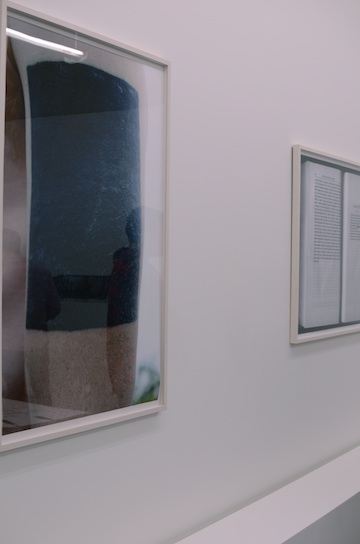
"Don't Worry, We'll Fix It", 2011, Anna Grey and Ryan Wilson Paulsen
There were aspects of gross failures throughout the festival, yet the ones that I witnessed seemed to somehow add to the general zeitgeist in spite of themselves, thus rendering a more dimensional picture of the times. The ways that they failed were not exactly necessary, yet grotesquely frought with such a level of irritation as to induce heavy doses of mental energy. After all this was an art show, not a display of seamless blue prints or a Hollywood blockbuster. We want to get punched in the brain and make jewelry out of faulty joinery as the ceiling caves. We want to think about failed languages and why things suck insatiably and vampirically. Stimulate us, art. Turn us on.
On the first and highest level of the exhibition's mish mash suck/awesome because of the suck salad is Young-Hae Chang Heavy Industries. This piece is incredibly irritating on a number of levels. It is visually cacophonous, a headless talking head. The voice that talks at you has no sound, a dogmatic visual noise producer. The speed at which the words arrive on the wall is slow, reminiscent of a children's phonetic lesson on learning to read. This cadence has a catch in it, most likely in efforts to psynch the text with the jazz which accompanies it (which is originally composed and one of the loveliest aspects of the piece), yet renders the final arrival of the actual verbage even more disappointing and even slightly condescending for holding its viewer in limbo interminably only to give so little in return. Timing is everything in things that describe themselves as comedic, but this isn't funny.
Yet what "Warning: For Laughs, No Redeeming Social Value" actually does do is comment on the way we communicate. The bulk of what we see and read comes from the internet or via a text based set of communications. Email, text messaging, skype, web based chatting, etc. is how we hear each other's voices and read the newspaper. Bookstores are shutting their doors every day to the print that has become digital. When this collaborative began working, the internet was a very different place. Not to say that the internet has become less of a wild west in terms of publishing, yet its weight and its credibility as a respected source of information and writing matures daily as it becomes an integral reference and tool. Perhaps this is why I expect YHCHI to not simply add to the trillionth source of vapidity via web based, streamlined graphics, not even as commentary. Maybe I don't want to witness again the things I already know and have seen a thousand times that day. It is indeed, a brave new world, thanks for reminding me.
The atmosphere of TBA:11 is not one geared towards the art industry. Its aim is not instant fame or slick and vapid production, yet it is one of brave nuance and the desperate lunge towards experimentation. TBA:11 is the wild card we drew on purpose. It is an exhibition rife with a pregnant discomfiture, its social implications electrifying and terrifying. Throughout the halls of the high school, the air is salted with punk symbols and the promise of theater. Dissatisfaction has become our most precious fodder, and bricks have a way of opening doors through smashed windows.























 "Don't Worry, We'll Fix It, Installation Shot, Anna Grey and Ryan Wilson Paulsen
"Don't Worry, We'll Fix It, Installation Shot, Anna Grey and Ryan Wilson Paulsen